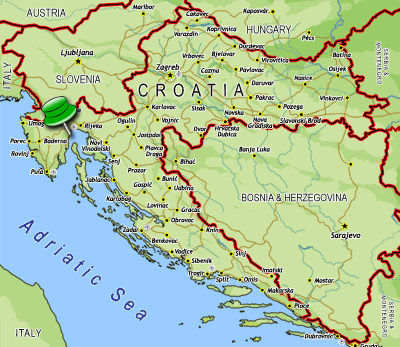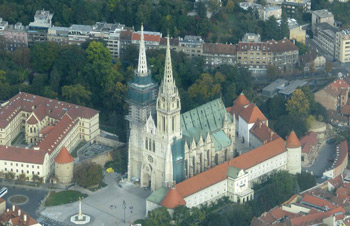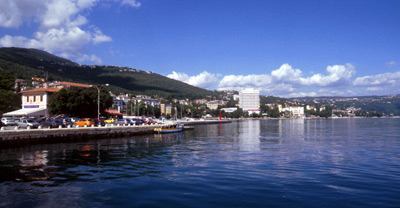Croatia, (Croatian Hrvatska) is located in southeastern Europe, on the Balkan Peninsula. Formerly one of the six republics of Yugoslavia, Croatia declared its independence in 1991. Zagreb is the capital and largest city. Croatia is located on the eastern side of the Adriatic Sea, across from Italy. The nation is shaped like the letter V lying on its side. Inside the V, to the southeast, is the country of Bosnia & Herzegovina; Croatia’s northern border faces Slovenia and Hungary; to the east lie Serbia and Montenegro. Croatia has a long coastline on the Adriatic Sea. More than 1,000 small islands fringe the coast and form part of Croatia’s territory. The scenic beauty of the Adriatic coast and the country’s rich cultural traditions attract more than 6 million tourists every year. In addition to tourism, the Croatian economy is balanced between industry, manufacturing, and agriculture. The country is rich in mineral resources, including petroleum, coal, and natural gas. The people of Croatia are mainly ethnic Croats. Until 1991 about 10 percent of the population was ethnic Serbs, along with a much smaller percentage of Hungarians and Italians. In mid-1991 fighting broke out between Croatian forces and Serb forces aided by the Serb-dominated Yugoslav Army. Thousands of people died and much of the country was heavily damaged. A peace accord reached in late 1995 ended the war. Since then, Croatia has worked to rebuild its economy and infrastructure.
The earliest known inhabitants of what is now Croatia were Illyrians, who were conquered by the Roman Empire by 10 AD. Their land, Illyricum, became the Roman provinces of Pannonia and Dalmatia. As Roman power declined, repeated invasions and widespread destruction carried out mainly by Germanic nations culminated in the 6th century in conquest by the Avars, a nomadic people of Mongolian and Turkic origin. Slavic tribes, who probably came with the Avars or were simply swept along from their original homeland (most likely the area of present-day Poland, Ukraine, and Belarus), settled over most of central and southeastern Europe. In Pannonia and Dalmatia they came to be called Croats (Hrvati), a name of disputed origin. At the end of the 8th century the armies of Frankish emperor Charlemagne destroyed the Avars. Croat and other Slavic tribal federations then established a number of small states between the Roman Catholic Frankish Empire on the west and the Orthodox Christian Byzantine Empire on the east. Most of the Slavic states frequently were dominated by one or the other empire. Those that were closer to the Frankish Empire, such as the Croats, became Roman Catholics; those closer to the Byzantine Empire became Eastern Orthodox Christians. The religious difference has been a major part of confrontations between Croats and Serbs ever since. By the reign of King Tomislav, Croatia had become an independent kingdom and had expanded in area to include both Pannonia and Dalmatia, and sometimes Bosnia. Opatija (pop 8,000) is a city in western Croatia, just southwest of Rijeka on the Adriatic coast in the Gulf of Kvarner in a sheltered position at the foot of Učka mountain. It is a popular summer and winter resort, with average temperatures of 10°C in winter, and 25°C in summer. Opatija is surrounded by beautiful woods of bay laurel. The whole sea-coast to the north and south of Opatija is rocky and picturesque, and contains several smaller winter resorts.The old 14th-century Benedictine abbey, Opatija Sv. Jakova ('Abbey of Saint Jacob'), from which the town derives its name (opatija means 'abbey' in Croatian) is located in Park Svetog Jakova or Saint Jacobs Park. The Saint Jacob church, built in 1506 and enlarged in 1937, now stands on the same spot. The neo-Romanesque Church of the Annunciation with its pronounced green cupola, was designed in 1906 by architect Karl Seidl.
The city's most prestigious sight is the Villa Angiolina, which was built in 1844 by Iginio Scarpa, a rich merchant from Rijeka. This villa, transformed into a hotel, gave a boost to tourism to this town. It became a fashionable destination for the Austrian imperial family and Austrian nobility. Soon more luxury hotels and villas were built, such as Hotel Kvarner, built in 1884. A new railway line was extended to Rijeka, from where one could go by tram to Opatija. The Austrian emperor Franz Joseph I used to spend here several months during winter. Many of these late 19th-century luxury hotels and villas have survived to present times. Opatija is known for the 'Maiden with the seagull', a statue by Zvonko Car (1956), which is positioned on a promontory by the Juraj Šporer art pavilion. It has turned into one of symbols of Opatija. A gilded variant of the statue Madonna, that once stood here, now stands in front of the Saint Jacob Church. The town park Angiolina contains many species of plants from all over the world. It has been protected since 1968. Close by, vis-a-vis Hotel Imperial, stands the statue 'The Fountain - Helios and Selena', a work of Austrian sculptor Hans Rathautsky from 1889. There is a 12 km-long promenade along the entire riviera, the Lungomare from Volosko, via Opatija, to Lovran. Leo Sternbach (1908-2005), born in Opatija, was the inventor of valium. |



